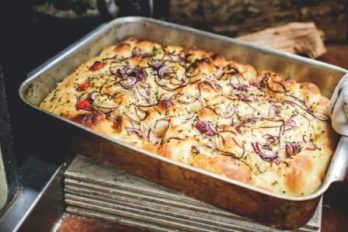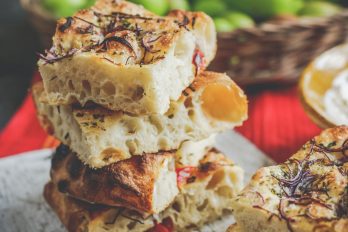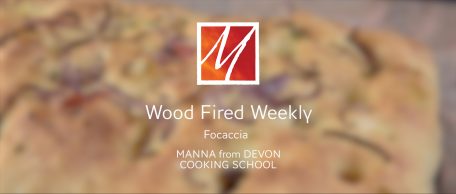Woodfired Focaccia
Woodfired Focaccia is one of the most popular breads on our village bread box delivery and known in some friends’ houses by the kids as David’s bread. The dough of the Woodfired Focaccia is a bit challenging to make as it’s so soft but it forms an incredible big pillow that gives a satisfying wobble when patted and you can just imagine sinking into it for an afternoon nap; well maybe …. The recipe uses a biga which is a pre-ferment made in advance to add flavour and texture to the dough so you need to plan ahead if you’re going to make some foccaccias – but you’ll be glad you did!
Woodfired Focaccia – Ingredients
For The Biga
250g 00 flour
250ml room temperature water
1g fast acting yeast
For the Dough
All the biga
500g 00 flour
60ml olive oil
5g fast acting yeast
15g fine sea salt
275ml water
For the Topping
100g cherry tomatoess, cut in half
3-4 sprigs fresh thyme
1 red onion, peeled and very thinly sliced
1tsp seasalt
2tbsp olive oil
Woodfired Focaccia – Equipment
Rectangular roasting tin
A heat deflector is very useful
Woodfired Focaccia – Method
To make the Biga
Mix the flour, water and yeast to make a wet batter. Cover and leave overnight or up to 36 hours.
To make the Dough
- Mix the yeast, flour, salt, 1tbsp of the oil and the water with the biga. Mix to a soft, sticky dough.
- Knead the dough on a clean surface for about 5 minutes. The dough will be pretty sticky but resist the temptation to add more flour; this wet dough will give a fabulous bubbly texture to your final bread. To knead the dough, it’s easier if you continuously lift it off the table with your finger tips, stretching it towards you and folding it back over itself. Try not to break through the outer surface of the dough as then it will become very messy – this sounds complicated but it’s just practise and worth the mess as it does make amazing foccaccia. See what David did in the video here
- Tip the remaining olive oil in to a baking tin. Place the dough on the oil. Cover and leave for 1 hour in a warm place.
Stretching and Folding
- Using the tips of your fingers dimple the surface of the dough, easing it gently into a rough rectangle.
- Stretch one end of the rectangle away from you and place it gently on to the middle section of the dough. Do the same with the end closest to you. Cover and leave to rise.
- Repeat this stretching, folding and resting process 2-3 times.
Topping
- Dibble out the dough with your fingers. Scatter the tomato halves across the dough, press each one firmly down into the dough. Cover the dough again and leave for 15 minutes.
- After 15 minutes dimple the dough again and press each piece of tomato further into the dough. Leave it for another 10 minutes.
- Press any tomatoes that are making a bid for freedom back into the dough and sprinkle on the herbs. Toss the onions in the 2tbsp oil and spread these over the dough then sprinkle generously with the coarse seasalt.

Just out of the oven
Baking
- Put the tin on the base of the oven, shut the door loosely so any remaining fire fumes can escape which they can’t if the oven door is on too tight.
- Bake the foccaccia until the upper surface is a good golden brown. If the bread is browning too quickly, put a deep roasting tin over the top in order to protect it. Half way through cooking, turn the pan around so that you get an even bake.
- The loaf should take about 15 minutes to bake – the focaccia will be golden brown and firm on top but still springy inside. Let the loaf rest for about 10 minutes before serving whilst still warm.

Ready for serving
We could make a very nice foccaccia without the biga or overnight ferment, in a couple of hours and without all the prior work involved in this recipe. So why don’t we ….. ?
….. Because whilst that one without the biga will be good, this one, with a little practice, will be the best foccaccia you’ll ever make. Trust us!
Let us know how you get on and see you next week for more woodfired weekly
David and Holly

The bread doctor is always in!


